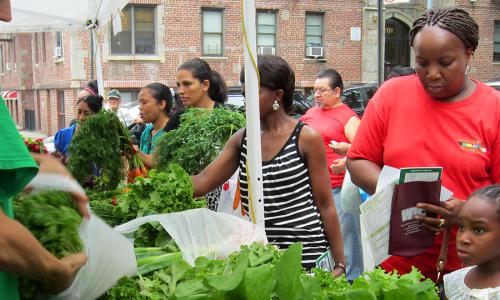Table of Contents
Throughout history, human communities have been challenged by a simple question: how do we make sure everyone has enough good food to eat?
Here in the 21st-century United States, with all our resources and technological prowess, we still struggle to answer that question. Though hunger is less widespread than it once was, food insecurity still clouds the lives of tens of millions of families. And in recent decades, we’ve created a new problem: not a shortage of food, but too much of the wrong kinds.
Eating ourselves sick
Diet-related illnesses like diabetes, hypertension and heart disease take a terrible toll in human lives, well-being, and healthcare costs. These health impacts hit the most vulnerable members of our communities hardest. And there is solid evidence connecting this epidemic of metabolic disease to a national diet that is far too high in processed foods and added sugar.
We know how to make ourselves healthier: eat more fruits, vegetables, whole grains and lean proteins, and cut down on added sugars, processed foods, and meat. The Dietary Guidelines for Americans, published every five years by USDA and the Department of Health and Human Services (HHS) has been communicating this science-based message to the public for a long time now.
Unfortunately, one key player is conspicuously ignoring the US government’s nutrition advice: the US government. Federal farm policy continues to incentivize overproduction of corn and soybeans, which are mostly used to produce—you guessed it—added sugar, processed foods, and meat. We need new policies that do more to enable US farmers to grow healthy food.
Increasing access to local and regional food
One way to help people eat healthier is to connect them with nearby farmers through farmers markets, community-supported agriculture (CSA) operations, or food hubs. By buying food from local, small-to-medium-sized farms, consumers can contribute to their community’s economic health as well as their own well-being. Legislation such as the Local FARMS Act of 2018 aims to help farmers find new local markets while improving food access for local residents, especially low-income communities and communities of color, where fresh, healthy food is often in short supply.
Ensuring healthy meals for kids
A healthy diet is especially important for children. Their bodies are growing and developing, and their tastes and habits are still forming. Moreover, millions of US children live in households that struggle with food insecurity. Federal programs that subsidize school meals play a vital role in ensuring that every kid in every classroom is well nourished and ready to learn. It’s important that these programs meet high standards for nutritional quality, but the processed food industry lobbies hard to lower the bar.
Preserving safety nets
According to the US Department of Agriculture’s Economic Research Service, more than one in 10 US households, and more than one in seven households with children, experienced food insecurity in 2017 – meaning that at times during the year, they either lacked access to enough food for their daily needs, or had to resort to coping strategies such as eating less varied diets or getting emergency food from community food pantries. Nutrition programs such as the Supplemental Nutrition Assistance Program (SNAP, aka food stamps) exist to help these families put nutritious meals on the table on a consistent basis. SNAP is a smart investment, lifting millions of families out of poverty each year, improving health and academic performance, and reducing medical costs. Yet each time the legislation that authorizes it comes up for renewal, SNAP becomes a political target. We need to continue defending this successful, cost-effective program.








